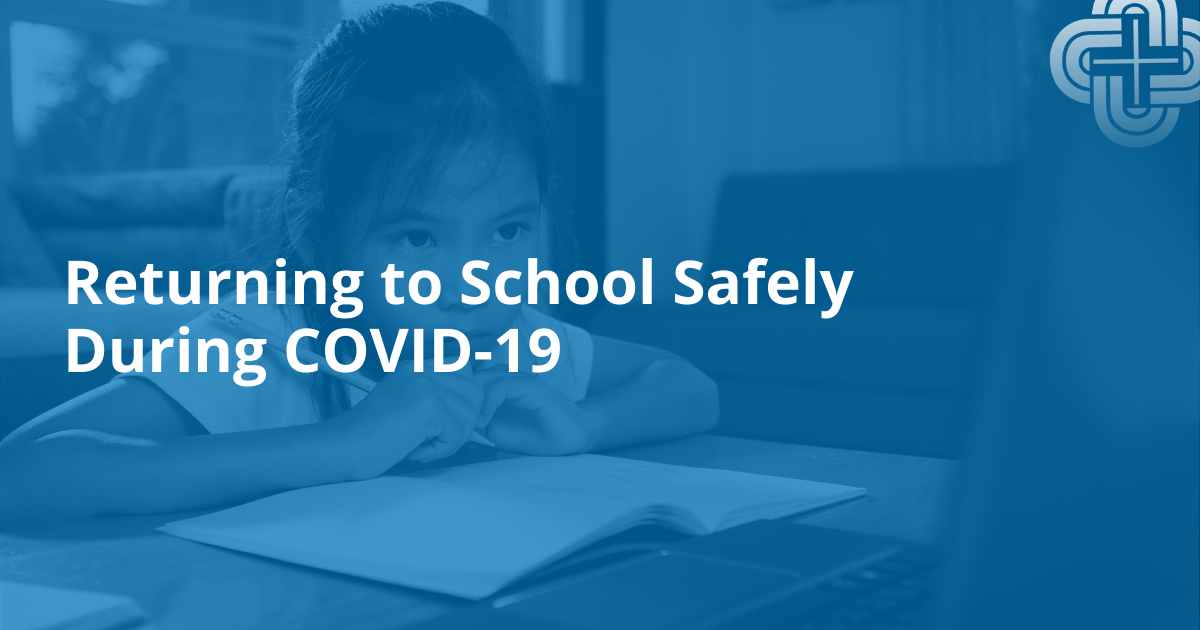Returning to School Safely During COVID-19
- Category: COVID-19
- Posted On:

Media Contact: Karina Rusk
831-759-1843
In August, California Governor Gavin Newsom announced that the 32 counties on the state’s COVID-19 monitoring list, which includes Monterey County, would begin the school year with distance learning until further notice. Counties not on the monitoring list could move forward with a return to the classroom.
Despite this regulatory directive, parents and teachers alike have a number of questions about COVID-19 and how it could impact their children’s safety as well as their own. Dr. Christine McCuistion, pediatrician at Salinas Valley Health Medical Center and Pacific Coast Pediatrics, provides important information for anyone who is concerned about the transition back to the classroom.
To listen to an interview on this topic with Dr. Christine McCuistion, pediatrician at Salinas Valley Health Medical Center and Pacific Coast Pediatrics, click here.
Children Fare Better than Adults
The good news, says Dr. McCuistion, is that children are seemingly not affected by the virus as severely as adults. “Fewer (children) are hospitalized and very few are requiring ICU. Actually, in California, at this point there have been zero deaths in children less than 17 years old. Multisystem inflammatory syndrome, which is associated with COVID-19, has also been rare with only six known cases,” explains Dr. McCuistion.
A number of studies are focusing on why children have a more powerful response to a COVID-19 infection. Some experts believe it has something to do with children’s T-cell response. Others are looking at angiotensin converting enzymes (ACE), the “door” that allows the virus to enter the respiratory system.
Another theory is that children’s immune systems interact with the virus differently than adults. Many adults are getting sick because their immune systems tend to overreact to the virus, but this is not occurring as much in children.
Precautionary Measures
Given the circumstances, distance learning is the safest option. Unfortunately, Dr. McCuistion says it’s not the ideal option. “It’s not an optimal situation, particularly for children with special needs or disabilities, children with autism; they're not going to be able to really learn by Zoom. It is concerning. It is best to return to in-person learning, because that’s where children learn the most,” she notes.
For schools that were able to open their classrooms, children in third grade and beyond have to wear masks or face shields. Some activities, like gym class, might not be occurring due to the face covering guidelines. Other precautions are being discussed as well, such as spreading out desk placement or only holding half-days to avoid kids gathering for lunch.
“Of course, parents can ask their school what is being done to keep kids well. A lot of schools have been doing a great job of proactively keeping parents informed as to all of the changes they are making to ensure the kids stay safe,” shares Dr. McCuistion.
Teacher & School Staff Safety
Kids are only one-half of the equation in terms of safely in the classroom. Teachers and other school staff also have concerns about exposure. Individuals over the age of 65 or with any underlying medical condition that puts them at increased risk should consult with their physician.
For teachers who don’t fall into that category, Dr. McCuistion points to the schools that have opened successfully in some European countries, as well as all the safety measures being put into place.
“I am so thankful for teachers and principals. They are such a valuable part in the lives of so many children and teenagers. I can't emphasize that enough,” says Dr. McCuistion. “I just hope that once the COVID-19 positivity rates come down, especially in our area, that every effort can be made to resume even partial in-person learning. Because the kids really need to see their teachers again and have that in-person instruction.”



